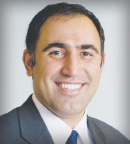
Amir T. Fathi, MD
Amir T. Fathi, MD, Associate Professor of Medicine at Harvard Medical School and Director of the Leukemia Program at Massachusetts General Cancer Center, said the approach of intensifying chemotherapy with the addition of venetoclax is one of several being studied in the upfront setting.
“Venetoclax as a single agent does not have significant activity, although it targets a key mediator of leukemogenic persistence. When you add it to conventional regimens, such as more intensive therapies, it seems to amplify the activity of the regimens,” Dr. Fathi explained.
“However, venetoclax can also be marrow-suppressive, and we have to be very careful when we add it, adjusting the duration of treatment and the length of the cycles. It takes a lot of expertise to manage these combinations,” he added. “Other combinations being looked at include FLAG [fludarabine, cytarabine, and granulocyte colony-stimulating factor], 7+3, and CPX-351, and venetoclax does seem to accentuate the ability of these regimens.”
“The challenge is that you have to pick your patients carefully and judiciously [for venetoclax plus high-intensity chemotherapy], because of adverse events and bleeding. While it is highly effective, it deepens myelosuppression. These combinations need to be studied further, and the oncology team needs to become more knowledgeable in handling them. It is early days,” he said.
Need for More Tolerable Combinations
Other investigators are approaching this question, exploring more tolerable combinations in younger patients with intermediate- and adverse-risk AML, Dr. Fathi explained. He and his colleagues are initiating an open-label, multicenter, randomized phase II trial to compare azacitidine and venetoclax vs 7+3 or CPX-351, in the hopes of identifying a gentler regimen that extends event-free survival but is not so difficult for patients to take. Planned enrollment is 172 patients.
“The question is whether we can transition younger patients out of the hospital and give them more easy-to-take regimens. This study excludes favorable-risk patients and those with NPM1 mutations who are younger,” Dr. Fathi said. “With these less-intensive regimens, patients will have a better chance of going on to transplant.”
“There are two tacks to take with venetoclax: add it to intensive regiments or take a regimen that is effective in older patients [venetoclax plus azacitidine] and compare these two approaches head to head,” he said.
“In my mind, the field is moving away from intensive therapies to more tolerable combinations,” Dr. Fathi said.
DISCLOSURE: Dr. Fathi has served as a consultant or advisor for Amgen, Immunogen, AbbVie/Servier, Genentech, Ipsen, Takeda, Kite Pharma, Novartis, Celgene/BMS, MorphoSys, Mablytics, Foghorn Therapeutics, Astellas Pharma, Orum, EnClear, PureTech, Agios, Blueprint Medicines, Daiichi Sankyo, Forty Seven Inc, Kura Oncology, Pfizer, Seattle Genetics, Trillium Therapeutics, Trovagene, and Forma; has received clinical trial support from AbbVie/Servier and Celgene/BMS; and has received research funding from AbbVie, Agios, Bristol Myers Squibb, Servier, and Takeda.

